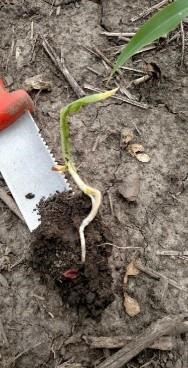By Alexander Lindsey
As the weather has turned warm this past week, many of our fields planted in April/early May should be emerged or be in the process of emerging. Cool temperatures paired with rain over the last few weeks may have resulted in seeds sitting in the ground longer than expected, or some fields experiencing imbibitional chilling or surface crusting as the soil dried. These conditions could result in stand reductions by preventing seeds from successfully germinating and emerging (Fig. 1). Concerns about stand have been raised with these earlier planted fields and this article discusses some considerations when making the replant decisions.

Figure 1. Corn seedling where emergence was impeded by soil crusting.
In an earlier article this year, we mentioned the first corn plants began emerging 110-120 soil growing degree days (base 50 degrees F) after planting. For planting depths greater than 1 inch, 90% emergence was seen after 177-182 soil growing degree days were accumulated. Depending on heat unit accumulation per day, this can vary slightly in the number of calendar days this total is reached after planting. An early stand count after this point is key when making replant decisions. Stand counts in corn planted in 30-inch rows should be conducted on a length of 17 ft 5 inches of row. This equates to 1/1000th of an acre being counted, so the quick way to get stand is to count the number of plants in 17 ft 5 inches of row and multiply by 1000. More information on corn stand counts (as well as quick demo) can be seen in this video: https://youtu.be/qvWLuSJvo9M?t=260
While stand loss contributes to a reduction in a field’s yield potential, planting date also plays a major role. In much of the state, yield potential declines as planting date gets later. Decisions related to replanting should take into account the initial planting date and existing stand, as well as how a later planting date with a higher stand compares. A useful guide to see if a replant is a viable choice can be found in the AGF-502 Factsheet (https://ohioline.osu.edu/factsheet/agf-502) as well as Chapter 4 – Corn Production of the Ohio Agronomy Guide (Table 4-13), and it has been reproduced below in Table 1.
Table 1. Planting date and final stand impacts on relative yield production in corn. |
Planting Date | Plants per Acre at Harvest |
10,000 | 15,000 | 20,000 | 25,000 | 30,000 | 35,000 |
Percent of Optimum Yield (%) |
April 10 | 62 | 76 | 86 | 92 | 94 | 93 |
April 20 | 67 | 81 | 91 | 97 | 99 | 97 |
April 30 | 68 | 82 | 92 | 98 | 100 | 98 |
May 9 | 65 | 79 | 89 | 95 | 97 | 96 |
May 19 | 59 | 73 | 84 | 89 | 91 | 89 |
May 29 | 49 | 63 | 73 | 79 | 81 | 79 |
The greatest yielding seeding rate and planting date combination was observed at 30,000 plants per acre final stand planted on April 30 (100%). In the case of an April planting, even if stand was reduced to 20,000 plants per acre, yield was only reduced by 9-14% compared to the highest yielding treatment. If a producer elected to replant this area on May 19 and achieved a stand of 30,000 plants per acre, the yield would still be 9% lower than the optimum (which is equivalent to the 20,000 plants per acre stand planted April 20).
This past week as well as the upcoming week should provide more clarity on these decisions with rising temperatures. Be sure to check with your seed representatives on procedures for getting seed for replanting, and also be on the lookout for any applicable herbicide restrictions related to replanting if weed control measures have already been applied.
Source : osu.edu